Miele K 9457 iD-4, K 9557 iD-3, K 9557 iD-4, K 9757 iD-3 Operating instructions
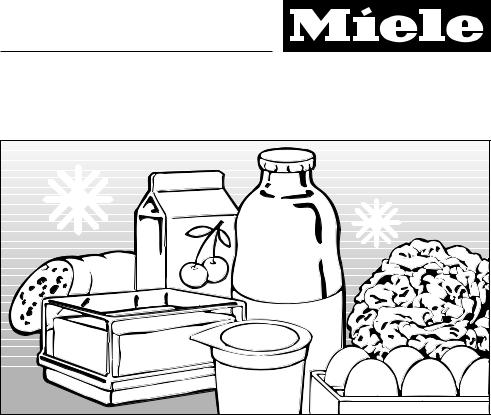
Operating and installation instructions
Refrigerator
with PerfectFresh zone and dynamic cooling
K 9457 iD-4
K 9557 iD-3/-4 K 9757 iD-3
To avoid the risk of accidents or |
en - GB |
damage to the appliance, it is |
|
essential to read these instructions |
|
before it is installed and used for the |
|
first time. |
M.-Nr. 09 016 100 |

Contents
Guide to the appliance . . . . . . . . . . . . . . . . . . . . . . . . . . . . . . . . . . . . . . . . . . . . . 4
Caring for the environment . . . . . . . . . . . . . . . . . . . . . . . . . . . . . . . . . . . . . . . . . . 6
Warning and Safety instructions . . . . . . . . . . . . . . . . . . . . . . . . . . . . . . . . . . . . . 7
How to save energy . . . . . . . . . . . . . . . . . . . . . . . . . . . . . . . . . . . . . . . . . . . . . . . 12
Switching on and off . . . . . . . . . . . . . . . . . . . . . . . . . . . . . . . . . . . . . . . . . . . . . . 13 Safety lock . . . . . . . . . . . . . . . . . . . . . . . . . . . . . . . . . . . . . . . . . . . . . . . . . . . . . . . 14 Switching off for longer periods of time . . . . . . . . . . . . . . . . . . . . . . . . . . . . . . . . . 14
The correct temperature . . . . . . . . . . . . . . . . . . . . . . . . . . . . . . . . . . . . . . . . . . . 15
. . . in the refrigerator and the PerfectFresh zone . . . . . . . . . . . . . . . . . . . . . . . . . 15 Dynamic cooling . . . . . . . . . . . . . . . . . . . . . . . . . . . . . . . . . . . . . . . . . . . . . . . . . . 15 Setting the temperature in the refrigerator. . . . . . . . . . . . . . . . . . . . . . . . . . . . . . . 15 Temperature range . . . . . . . . . . . . . . . . . . . . . . . . . . . . . . . . . . . . . . . . . . . . . . 16 Setting the temperature in the PerfectFresh zone . . . . . . . . . . . . . . . . . . . . . . . . . 16 Temperature display . . . . . . . . . . . . . . . . . . . . . . . . . . . . . . . . . . . . . . . . . . . . . . . 17 Temperature display brightness. . . . . . . . . . . . . . . . . . . . . . . . . . . . . . . . . . . . 17
Alarm. . . . . . . . . . . . . . . . . . . . . . . . . . . . . . . . . . . . . . . . . . . . . . . . . . . . . . . . . . . 18 Switching the alarm off early . . . . . . . . . . . . . . . . . . . . . . . . . . . . . . . . . . . . . . . . . 18 Switching on the alarm system . . . . . . . . . . . . . . . . . . . . . . . . . . . . . . . . . . . . . . . 18
Super cool . . . . . . . . . . . . . . . . . . . . . . . . . . . . . . . . . . . . . . . . . . . . . . . . . . . . . . 19
Storing food in the refrigerator. . . . . . . . . . . . . . . . . . . . . . . . . . . . . . . . . . . . . . 20 Different storage zones . . . . . . . . . . . . . . . . . . . . . . . . . . . . . . . . . . . . . . . . . . . . . 20 Food which is not suitable for storing in the refrigerator . . . . . . . . . . . . . . . . . . . . . 21 When shopping for food . . . . . . . . . . . . . . . . . . . . . . . . . . . . . . . . . . . . . . . . . . . . . 21 Storing food correctly . . . . . . . . . . . . . . . . . . . . . . . . . . . . . . . . . . . . . . . . . . . . . . 21
Unpacked meat and vegetables . . . . . . . . . . . . . . . . . . . . . . . . . . . . . . . . . . 21
Storing food in the PerfectFresh zone . . . . . . . . . . . . . . . . . . . . . . . . . . . . . . . . 22 Storage temperature . . . . . . . . . . . . . . . . . . . . . . . . . . . . . . . . . . . . . . . . . . . . . . . 22 Humidity level . . . . . . . . . . . . . . . . . . . . . . . . . . . . . . . . . . . . . . . . . . . . . . . . . . . . 22 Storing food in the PerfectFresh zone compartments . . . . . . . . . . . . . . . . . . . . . . 22 Dry compartment . . . . . . . . . . . . . . . . . . . . . . . . . . . . . . . . . . . . . . . . . . . . . . . 22 Humidity-controlled compartment . . . . . . . . . . . . . . . . . . . . . . . . . . . . . . . . . . 23
Adjusting the interior fittings . . . . . . . . . . . . . . . . . . . . . . . . . . . . . . . . . . . . . . . 26 Moving the shelves . . . . . . . . . . . . . . . . . . . . . . . . . . . . . . . . . . . . . . . . . . . . . . . . 26 Split shelf . . . . . . . . . . . . . . . . . . . . . . . . . . . . . . . . . . . . . . . . . . . . . . . . . . . . . . . . 26 Adjusting the condiment tray/bottle shelf . . . . . . . . . . . . . . . . . . . . . . . . . . . . . . . 27 Universal container . . . . . . . . . . . . . . . . . . . . . . . . . . . . . . . . . . . . . . . . . . . . . . . . 28 Moving the bottle divider . . . . . . . . . . . . . . . . . . . . . . . . . . . . . . . . . . . . . . . . . . . . 28

Contents
Automatic defrost . . . . . . . . . . . . . . . . . . . . . . . . . . . . . . . . . . . . . . . . . . . . . . . . 29 Refrigerator section and PerfectFresh zone . . . . . . . . . . . . . . . . . . . . . . . . . . . . . 29
Cleaning and care . . . . . . . . . . . . . . . . . . . . . . . . . . . . . . . . . . . . . . . . . . . . . . . . 30 Cleaning the interior and accessories . . . . . . . . . . . . . . . . . . . . . . . . . . . . . . . . . . 31 Ventilation gaps . . . . . . . . . . . . . . . . . . . . . . . . . . . . . . . . . . . . . . . . . . . . . . . . . . . 32 Door seal . . . . . . . . . . . . . . . . . . . . . . . . . . . . . . . . . . . . . . . . . . . . . . . . . . . . . . . . 32
Problem solving guide . . . . . . . . . . . . . . . . . . . . . . . . . . . . . . . . . . . . . . . . . . . . 33
Noises . . . . . . . . . . . . . . . . . . . . . . . . . . . . . . . . . . . . . . . . . . . . . . . . . . . . . . . . . 35
After Sales / Guarantee . . . . . . . . . . . . . . . . . . . . . . . . . . . . . . . . . . . . . . . . . . . . 36
Electrical connection. . . . . . . . . . . . . . . . . . . . . . . . . . . . . . . . . . . . . . . . . . . . . . 37
Installation . . . . . . . . . . . . . . . . . . . . . . . . . . . . . . . . . . . . . . . . . . . . . . . . . . . . . . 38 Location . . . . . . . . . . . . . . . . . . . . . . . . . . . . . . . . . . . . . . . . . . . . . . . . . . . . . . . . . 38 Side-by-side. . . . . . . . . . . . . . . . . . . . . . . . . . . . . . . . . . . . . . . . . . . . . . . . . . . . . . 38 Climate range . . . . . . . . . . . . . . . . . . . . . . . . . . . . . . . . . . . . . . . . . . . . . . . . . . 38 Ventilation . . . . . . . . . . . . . . . . . . . . . . . . . . . . . . . . . . . . . . . . . . . . . . . . . . . . . . . 39 Before installing the appliance . . . . . . . . . . . . . . . . . . . . . . . . . . . . . . . . . . . . . . . 39 Does your old appliance have a different hinging mechanism? . . . . . . . . . . . . . . 40 Stainless steel front. . . . . . . . . . . . . . . . . . . . . . . . . . . . . . . . . . . . . . . . . . . . . . 40
Building-in dimensions . . . . . . . . . . . . . . . . . . . . . . . . . . . . . . . . . . . . . . . . . . . 41
Adjusting the door hinges . . . . . . . . . . . . . . . . . . . . . . . . . . . . . . . . . . . . . . . . . 42
Changing the door hinging . . . . . . . . . . . . . . . . . . . . . . . . . . . . . . . . . . . . . . . . . 43 Appliance door . . . . . . . . . . . . . . . . . . . . . . . . . . . . . . . . . . . . . . . . . . . . . . . . . . . 43
Building in the appliance . . . . . . . . . . . . . . . . . . . . . . . . . . . . . . . . . . . . . . . . . . 46 Weight of the furniture door . . . . . . . . . . . . . . . . . . . . . . . . . . . . . . . . . . . . . . . . . . 46 Building into a peninsular run . . . . . . . . . . . . . . . . . . . . . . . . . . . . . . . . . . . . . . . . 46 Fitting a furniture door . . . . . . . . . . . . . . . . . . . . . . . . . . . . . . . . . . . . . . . . . . . . . . 50

Guide to the appliance
|
|
|
|
|
|
|
|
|
|
|
|
|
|
|
|
|
|
|
|
|
|
|
|
|
|
|
|
|
|
|
|
|
|
|
|
|
|
|
|
|
|
|
|
|
|
|
|
|
|
|
|
|
|
|
|
|
|
|
|
|
|
|
|
|
|
|
|
|
|
|
|
|
|
|
|
|
|
|
|
|
|
|
|
|
|
|
|
aSafety lock indicator light |
dTemperature selector buttons |
||||||||||||||||||||
bOn/Off button |
(+ for warmer; – for colder) |
||||||||||||||||||||
|
|
|
|
|
|
|
|
|
|
|
|
|
|
|
|
|
|
|
|||
cRefrigerator temperature display |
eSuper cool button and |
||||||||||||||||||||
indicator light |
|||||||||||||||||||||
|
|
||||||||||||||||||||
|
|
fAlarm off button |
|||||||||||||||||||
4
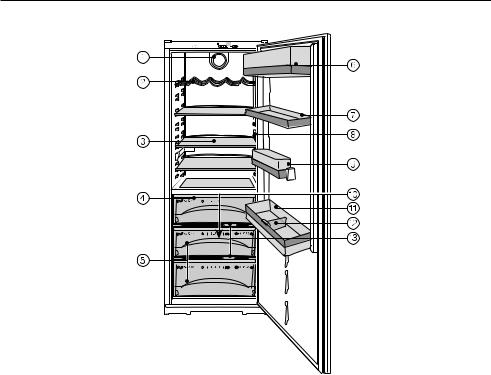
Guide to the appliance
aFan for dynamic cooling
bBottle rack
cAdjustable shelves
dPerfectFresh zone, dry compartment
ePerfectFresh zone, humidity controlled compartments
(or compartment, depending on model)
fButter and cheese compartment
gEgg tray/Condiment tray
hInterior lighting
iUniversal container*
jCondensate channel and drain hole
kBottle shelf
lBottle divider
mRegulator to set the humidity level in the humidity controlled compartments
(or compartment, depending on model)
* Depending on model
5
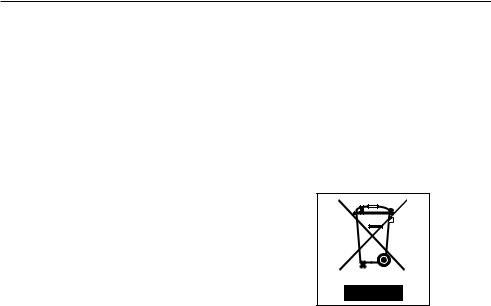
Caring for the environment
Disposal of the packing material
The transport and protective packing has been selected from materials which are environmentally friendly for disposal, and should be recycled.
Ensure that any plastic wrappings, bags etc. are disposed of safely and kept out of the reach of babies and young children. Danger of suffocation!
Disposal of your old appliance
Electrical and electronic appliances often contain materials which, if handled or disposed of incorrectly, could be potentially hazardous to human health and to the environment. They are, however, essential for the correct functioning of your appliance. Please do not therefore dispose of it with your household waste.
Please dispose of it at your local community waste collection / recycling centre or contact your dealer for advice. Ensure that it presents no danger to children while being stored for disposal.
Take care not to damage the pipework at the back of it before or during transportation to an authorised collection depot.
In this way, refrigerant in the pipework and oil in the compressor will be contained, and will not leak out into the environment.
6

Warning and Safety instructions
This appliance complies with all relevant legal safety requirements. Improper use of the appliance can, however, present a risk of both personal injury and material damage.
To avoid the risk of accidents and damage to the appliance, please read these instructions carefully before installation and before using it for the first time. They contain important notes on the installation, safety, operation and care of the appliance.
Keep these instructions in a safe place and pass them on to any future user.
Correct application
~This appliance is not designed for commercial use. It is intended for use in domestic households and in similar working and residential environments. This appliance is not intended for outdoor use.
~This appliance is intended for domestic use only, to cool and store foodstuffs.
Any other usage is not supported by the manufacturer and could be dangerous. Miele cannot be held liable for damage resulting from incorrect or improper use or operation of the appliance.
~ The appliance can only be used by people with reduced physical, sensory or mental capabilities, or lack of experience and knowledge, if they are supervised whilst using it, or have been shown how to use it in a safe way and understand the hazards involved.
Safety with children
~Children under 8 years of age must be kept away from the appliance unless they are constantly supervised.
~Children 8 years and older may only use the appliance without supervision if they have been shown how to use it in a safe way and understand the hazards involved.
~Children must not be allowed to clean or maintain the appliance unsupervised.
~This appliance is not a toy! To prevent the risk of injury, do not allow children to play with it, for example to climb inside the drawers or to swing on the door.
~The door hinges can cause injury. Keep children well away at all times.
~Do not allow children to play with the packaging material, e.g. plastic bags and wrappings. Danger of suffocation.
7

Warning and Safety instructions
Technical safety
~Before setting up the appliance, check it for any externally visible damage.
Do not install and use a damaged appliance.
~This appliance contains the coolant Isobutane (R600a), a natural gas which is environmentally friendly. Although it is flammable, it does not damage the ozone layer and does not increase the greenhouse effect. The use of this coolant has, however, led to a slight increase in the noise level of the appliance. In addition to the noise of the compressor, you might be able to hear the coolant flowing around the system. This is unavoidable, but does not have any adverse effect on the performance of the appliance.
Care must be taken during the transportation and setting up of the appliance that no parts of the cooling system are damaged. Leaking coolant can be harmful to the eyes.
In the event of any damage:
- avoid open fires and anything which creates a spark,
- disconnect from the mains,
- air the room in which the appliance is located for several minutes and
- contact the Service Department for advice.
~The more coolant there is in an appliance, the larger the room it should be installed in. In the event of a leakage, if the appliance is in a small room, there is the danger of
combustible gases building up.
For every 8 g of coolant at least 1 m3 of room space is required. The amount of coolant in the appliance is stated on the data plate inside the appliance.
~Before connecting the appliance to the mains supply, make sure that the rating on the data plate corresponds to the voltage and frequency of the household supply.
This data must correspond in order to avoid the risk of damage to the appliance. Consult a qualified electrician if in any doubt.
~The electrical safety of this appliance can only be guaranteed when continuity is complete between it and an effective earthing system which complies with current local and national safety regulations. It is most important that this basic safety requirement is present and tested regularly, and where there is any doubt, the household wiring system should be inspected by a qualified electrician. The manufacturer cannot be held liable for damage or injury caused by the lack of or inadequacy of an effective earthing system (e.g. electric shock).
~If the connection cable is faulty it must only be replaced by a Miele approved service technician to protect the user from danger.
8

Warning and Safety instructions
~Safe operation of the appliance is only assured if it has been installed and connected in accordance with these operating and installation instructions.
~This appliance must not be used in a non-stationary location (e.g. on a ship).
~Installation work, maintenance and repairs may only be carried out by suitably qualified and competent persons in accordance with national and local safety regulations.
Repairs and other work by unqualified persons could be dangerous and the manufacturer will not be held liable.
Ensure current is not supplied to the appliance until after maintenance or repair work has been carried out.
~The appliance is only completely isolated from the electricity supply when:
–it has been switched off at the wall socket and the plug has been withdrawn,
–the mains fuse is withdrawn, or
–the screw-out fuse is removed in countries where this is applicable.
~ Do not connect the appliance to the mains electricity supply by an extension lead.
Extension leads do not guarantee the required safety of the machine (e.g. danger of overheating).
~ In countries where there are areas which may be subject to infestation by cockroaches or other vermin, pay particular attention to keeping the appliance and its surroundings in a clean condition at all times. Any damage which may be caused by cockroaches or other vermin will not be covered by the guarantee.
Correct use
~Never store explosive materials in the appliance or any products containing propellants (e.g. spray cans). Thermostats switching on may produce sparks which could present a fire hazard. Flammable compounds could explode.
~Do not operate any electrical equipment (e.g. an electric ice-cream maker) inside the appliance. Danger of sparking and explosion.
~If storing alcohol with a high percentage proof, make sure it is tightly closed and stored upright.
Danger of explosion.
~Observe the "use by" dates given on food to avoid the risk of food poisoning. Storage times will depend on several factors, including the freshness and quality of the food as well as the temperature at which it is stored. Follow the instructions given on the food manufacturer’s packaging on storage conditions required.
9

Warning and Safety instructions
~ Do not use sharp edged objects to
–remove frost and ice,
–separate food which has become frozen.
They will damage the evaporator, causing irreversible damage to the appliance.
~Do not use defrosting sprays or de-icers, as they might contain substances which could damage the plastic parts or which could cause a build-up of gases and pose a danger to health.
~Do not use any oils or grease on the door seal as these will cause the seal to become porous with time.
~Do not store cooking oil in the refrigerator door. Traces of oil can cause stress cracks to occur in the plastic components in the door.
~Do not block the ventilation gap in the plinth or the top of the appliance housing unit as this would impair the efficiency of the appliance, increase the electricity consumption and could cause damage to the appliance.
~The appliance is designed for use within certain climate ranges (ambient temperatures), and should not be used outside this range. The climate range for your appliance is stated on the data plate inside the appliance.
Installing it in a room with too low an ambient temperature, e.g. a garage, can lead to the appliance switching off for longer periods so that it cannot maintain the required temperature.
~ Never use a steam-cleaning appliance to clean this appliance. Pressurised steam could reach the electrical components and cause a short circuit.
Disposal of your old appliance
~Before disposing of an old appliance first make the door latch or lock unusable.
This way you will prevent children from accidentally locking themselves in and endangering their lives.
~Be careful not to damage any part of the pipework whilst awaiting disposal, e.g. by
–puncturing the refrigerant channels in the evaporator.
–bending any pipework.
–scratching the surface coating.
Splashes of refrigerant can damage the eyes.
The manufacturer cannot be held liable for damage caused by non-compliance with these Warning and Safety instructions.
10
|
|
|
How to save energy |
|
|
|
|
|
Normal energy |
|
Increased energy |
|
|
||
|
consumption |
|
consumption |
|
|
|
|
|
|
|
|
Installation site |
In a ventilated room. |
|
In an enclosed, unventilated room. |
|
|
|
|
|
Protected from direct sunlight. |
|
In direct sunlight. |
|
|
|
|
|
Not near to a heat source (radiator, |
|
Near to a heat source (radiator, |
|
oven). |
|
oven). |
|
|
|
|
|
Where the ideal ambient room |
|
Where there is a high ambient room |
|
temperature is approx. 20°C. |
|
temperature. |
|
|
|
|
|
Do not cover the ventilation gaps |
|
|
|
and dust them regularly. |
|
|
|
|
|
|
|
|
|
|
Temperature setting |
With a medium setting of 2 to 3. |
|
With a high setting: the lower the |
with a thermostat |
|
|
temperature in the compartment, the |
which is approximate |
|
|
higher the energy consumption. |
(set in stages). |
|
|
|
|
|
|
|
|
|
|
|
Temperature setting |
Larder section 8 to 12 °C |
|
|
with a thermostat which |
|
|
On appliances with winter setting, |
Refrigerator section 4 to 5 °C |
|
||
is exact to the degree |
|
|
please make sure that the winter |
PerfectFresh zone just above 0 °C |
|
||
(digital display). |
|
setting is switched off when the |
|
|
|
||
|
Freezer section -18 °C |
|
ambient temperature is warmer than |
|
|
|
|
|
|
|
16 °C . |
|
Wine storage section 10 to 12 °C |
|
|
|
|
|
|
|
|
|
|
|
|
|
|
Use |
Drawers, shelves and racks |
|
|
|
arranged as they were when the |
|
|
|
appliance was delivered. |
|
|
|
|
|
|
|
Only open the door when necessary |
|
Frequent opening of the door for |
|
and for as short a time as possible. |
|
long periods will cause a loss of |
|
|
|
coldness. |
|
|
|
|
|
Store food in an organised way. |
|
Searching for an item will mean the |
|
|
|
door is open for longer. |
|
|
|
|
|
Allow hot food and drinks to cool |
|
Hot food will cause the compressor |
|
down before placing them in the |
|
to run for a long time, as the |
|
appliance. |
|
appliance will have to work harder |
|
|
|
to reduce the temperature. |
|
|
|
|
|
Store food covered or packaged. |
|
The evaporation or condensation of |
|
|
|
liquids will cause a loss of coldness |
|
|
|
in the refrigerator. |
|
|
|
|
|
Place frozen food in the refrigerator |
|
|
|
to defrost. |
|
|
|
|
|
|
|
Do not over-fill the appliance to |
|
|
|
allow air to circulate. |
|
|
|
|
|
|
|
|
|
|
Defrosting |
Defrost the freezer section when a |
|
A layer of ice hinders the cold from |
|
layer of ice 0.5 cm thick (maximum) |
|
reaching the frozen food, and |
|
has built up. |
|
increases energy consumption. |
|
|
|
|
11
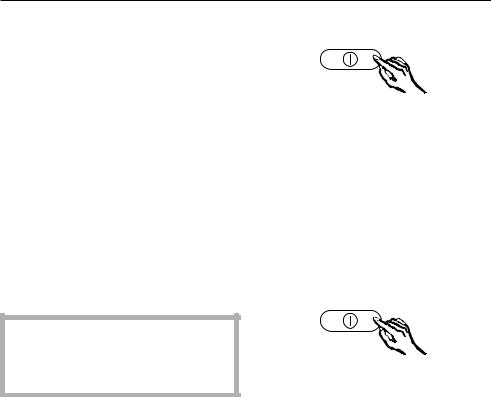
Switching on and off
Before using for the first time |
Switching on |
Protective foil
The stainless steel trim, frames and panels have a layer of protective foil to prevent scratching during transportation.
^Carefully remove the protective foil from them.
Cleaning and care
^After removing the protective foil, treat stainless steel surfaces with the Miele stainless steel conditioning agent supplied with the appliance (available to re-order from www.miele-shop.com).
Important! Each time it is used, the Miele stainless steel conditioning agent forms a water and dirt repellent protective coating.
^Clean the inside of the appliance and the accessories with lukewarm water and a little washing-up liquid, and then dry with a soft cloth.
^ Press the On/Off button.
The temperature display lights up, the appliance starts cooling and the interior light will come on when the door is opened.
To enable the temperature to get sufficiently cold inside the appliance, allow the appliance to run for a few hours before placing food in it.
Switching off
^Press the On/Off button until the temperature display goes out.
The cooling system is switched off. (If this does not happen, the safety lock is still activated).
12
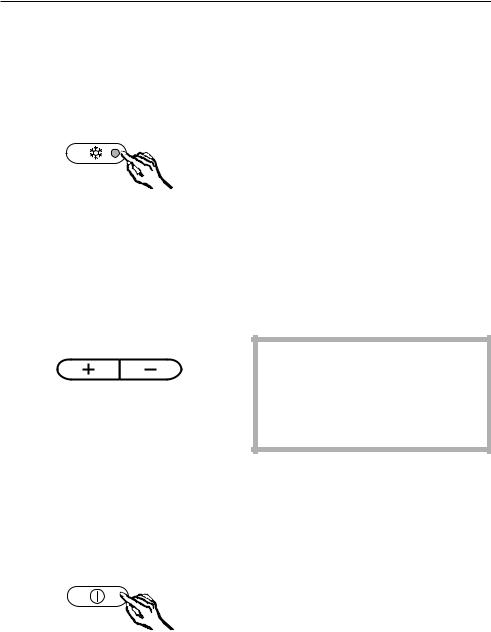
Switching on and off
Safety lock
The safety lock can be activated to prevent the appliance being switched off inadvertently.
Activating or de-activating the safety lock
^Press and hold the Super cool button pressed in for approx. 5 seconds.
The Super cool indicator light flashes, and a ; flashes in the temperature display.
^ Press the Super cool button again.
; will light up in the display.
^You can now choose between ; 0 and ; 1 by pressing the temperature selector buttons:
0: the safety lock is de-activated,
1: the safety lock is activated.
^Press the Super cool button to save the setting.
The safety lock indicator light X will light up when the safety lock has been activated.
^Press the On/Off button to come out of the setting mode.
If you do not do this, the electronics will switch over to normal operation automatically after a couple of minutes.
Switching off for longer periods of time
If the appliance is not going to be used for a longer period of time, e.g. whilst on holiday:
^switch the appliance off,
^disconnect it from the mains. Switch off at the wall and withdraw the plug from the socket, or disconnect the mains fuse.
^clean the appliance out and
^leave the door ajar to air the appliance.
If, during a long absence, the appliance is switched off but not cleaned out and the door is left shut, there is a danger of mould and odours building up inside the appliance.
13

The correct temperature
It is very important to set the correct temperature for storing food in the appliance. Micro-organisms will cause food which is not stored at the correct temperature to deteriorate rapidly. Temperature influences the growth rate of these micro-organisms. Reducing the temperature reduces their growth rate.
The temperature in the appliance will rise:
–the more often the door is opened and the longer it is kept open,
–if too much food is stored in it at once,
–the warmer the food is which is being put into it,
–the higher the ambient temperature surrounding the appliance.
The appliance is designed for use in specific ambient temperatures (climate ranges). Do not use in ambient temperatures for which it is not designed.
. . . in the refrigerator and the PerfectFresh zone
We recommend a temperature of 4 °C in the refrigerator.
The temperature in the PerfectFresh zone is controlled automatically, and is maintained at 0 to 3 °C.
Dynamic cooling
The dynamic cooling fan automatically switches on when the cooling system for the refrigerator switches on. It distributes the temperature in the appliance to all areas more evenly so that all the food will be chilled to about the same degree.
Setting the temperature in the refrigerator
Use the two buttons underneath the temperature display to set the temperature for the refrigerator.
Press the
+ button : to raise the temperature (it gets warmer)
– button: to reduce the temperature (it gets cooler).
The temperature being set will flash in the display.
When pressing the buttons, the following information shows in the display:
–When first pressed, the last temperature selected flashes.
–Each subsequent press of the button adjusts the temperature shown in
1 °C steps.
–Keeping the button pressed in adjusts the temperature continually.
14
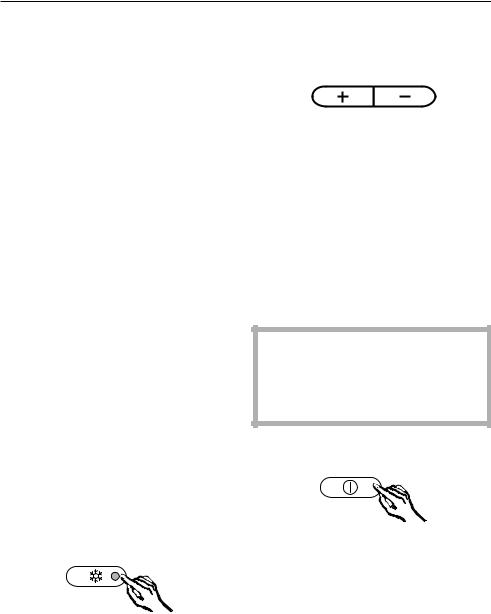
The correct temperature
Approx. 5 seconds after letting go of the button, the current average temperature of the refrigerator is automatically shown.
If you have adjusted the temperature, wait for approx. 6 hours if the appliance is not very full and for approx. 24 hours if the appliance is full, before checking the temperature display, as it will take this long for the display to give an accurate reading. If, after this time, the temperature is still too high or too low, you will need to adjust it again.
Temperature range
The temperature can be adjusted from: 4 °C to 9 °C
The ambient temperature in the room and the installation location can affect the time it takes for the appliance to reach the lowest temperature. If the ambient temperature is too high, the appliance may not reach the lowest temperature.
Setting the temperature in the PerfectFresh zone
The temperature in the PerfectFresh zone is automatically held at 0 to 3 °C. It can be raised or lowered, e.g. if you want to use it for storing items like fish.
^Press and hold the Super cool button pressed in for approx. 5 seconds.
The Super cool indicator light flashes, and a ; flashes in the temperature display.
^Press one of the temperature selector buttons repeatedly until a = appears in the display. Press the Super cool button again.
= lights up in the display.
^You can now adjust the temperature in the PerfectFresh zone by pressing the temperature selector buttons. You can choose from settings 1 to 9:
1: lowest temperature,
9: highest temperature.
=5 is the default setting for the PerfectFresh zone. If a setting of = 1 to = 4 is selected, the temperature can fall below 0°C. Food could freeze!
^Press the Super cool button to save the setting.
^Press the On/Off button to come out of setting mode.
If you do not do this, the electronics will switch over to normal operation automatically after a couple of minutes.
15
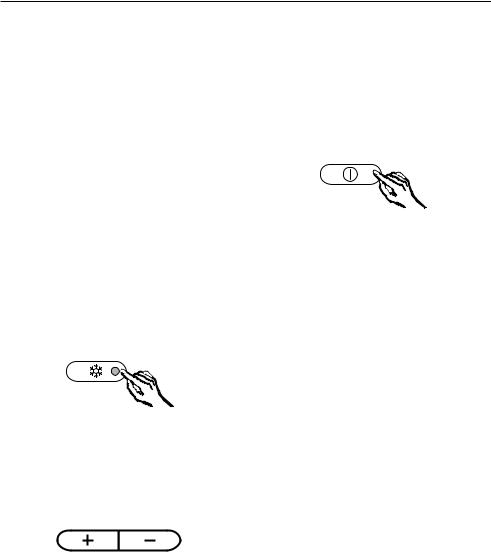
The correct temperature
Temperature display
During normal operation, the temperature display on the control panel shows the average temperature in the refrigerator.
If the temperature is not within the range that the appliance is able to display, bars will flash in the temperature display.
Temperature display brightness
The appliance is supplied with the brightness of the temperature display set as low as possible. However, if the door is opened, a setting changed or if the alarm is sounding, the temperature display will appear much brighter.
The level of brightness can be adjusted:
^Press and hold the Super cool button pressed in for approx. 5 seconds.
The Super cool indicator light flashes, and a ; flashes in the temperature display.
^Press one of the temperature selector buttons repeatedly until ^ appears in the display.
^Press the Super cool button again.
^lights up in the display.
^You can now adjust the level of brightness by pressing the temperature selector buttons. You can choose from settings 1 to 5: 1: dimmest setting,
5: brightest setting.
^Press the Super cool button to save the setting.
^Press the On/Off button to come out of setting mode.
If you do not do this, the electronics will switch over to normal operation automatically after a couple of minutes.
16

Alarm
Your appliance has been fitted with an alarm to avoid energy being wasted if the door is left open and to prevent stored food becoming too warm.
The alarm will sound if the door is left open for more than approx. 60 seconds. The alarm will stop as soon as the door is closed.
If you want to keep the door open for more than approx. 60 seconds, intentionally, we recommend that you switch the alarm off.
Switching the alarm off early
^Press the alarm off button. The alarm will stop.
Switching on the alarm system
The alarm system switches back on automatically as soon as the door is closed. It does not have to be switched on manually.
17
